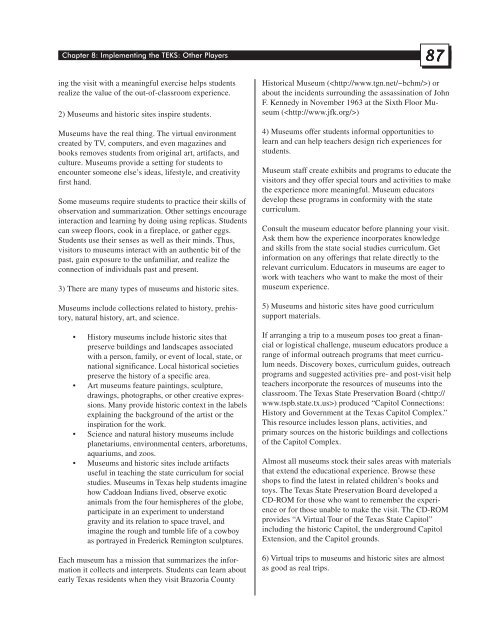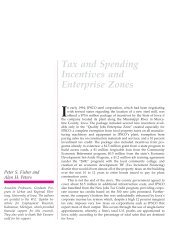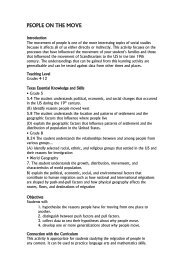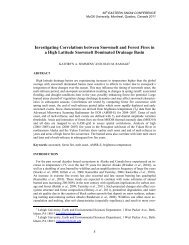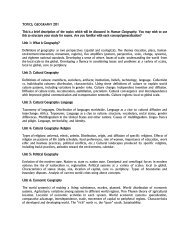Texas Social Studies Framework - Department of Geography ...
Texas Social Studies Framework - Department of Geography ...
Texas Social Studies Framework - Department of Geography ...
You also want an ePaper? Increase the reach of your titles
YUMPU automatically turns print PDFs into web optimized ePapers that Google loves.
Chapter 8: Implementing the TEKS: Other Players<br />
ing the visit with a meaningful exercise helps students<br />
realize the value <strong>of</strong> the out-<strong>of</strong>-classroom experience.<br />
2) Museums and historic sites inspire students.<br />
Museums have the real thing. The virtual environment<br />
created by TV, computers, and even magazines and<br />
books removes students from original art, artifacts, and<br />
culture. Museums provide a setting for students to<br />
encounter someone else’s ideas, lifestyle, and creativity<br />
first hand.<br />
Some museums require students to practice their skills <strong>of</strong><br />
observation and summarization. Other settings encourage<br />
interaction and learning by doing using replicas. Students<br />
can sweep floors, cook in a fireplace, or gather eggs.<br />
Students use their senses as well as their minds. Thus,<br />
visitors to museums interact with an authentic bit <strong>of</strong> the<br />
past, gain exposure to the unfamiliar, and realize the<br />
connection <strong>of</strong> individuals past and present.<br />
3) There are many types <strong>of</strong> museums and historic sites.<br />
Museums include collections related to history, prehistory,<br />
natural history, art, and science.<br />
• History museums include historic sites that<br />
preserve buildings and landscapes associated<br />
with a person, family, or event <strong>of</strong> local, state, or<br />
national significance. Local historical societies<br />
preserve the history <strong>of</strong> a specific area.<br />
• Art museums feature paintings, sculpture,<br />
drawings, photographs, or other creative expressions.<br />
Many provide historic context in the labels<br />
explaining the background <strong>of</strong> the artist or the<br />
inspiration for the work.<br />
• Science and natural history museums include<br />
planetariums, environmental centers, arboretums,<br />
aquariums, and zoos.<br />
• Museums and historic sites include artifacts<br />
useful in teaching the state curriculum for social<br />
studies. Museums in <strong>Texas</strong> help students imagine<br />
how Caddoan Indians lived, observe exotic<br />
animals from the four hemispheres <strong>of</strong> the globe,<br />
participate in an experiment to understand<br />
gravity and its relation to space travel, and<br />
imagine the rough and tumble life <strong>of</strong> a cowboy<br />
as portrayed in Frederick Remington sculptures.<br />
Each museum has a mission that summarizes the information<br />
it collects and interprets. Students can learn about<br />
early <strong>Texas</strong> residents when they visit Brazoria County<br />
87<br />
87<br />
Historical Museum () or<br />
about the incidents surrounding the assassination <strong>of</strong> John<br />
F. Kennedy in November 1963 at the Sixth Floor Museum<br />
()<br />
4) Museums <strong>of</strong>fer students informal opportunities to<br />
learn and can help teachers design rich experiences for<br />
students.<br />
Museum staff create exhibits and programs to educate the<br />
visitors and they <strong>of</strong>fer special tours and activities to make<br />
the experience more meaningful. Museum educators<br />
develop these programs in conformity with the state<br />
curriculum.<br />
Consult the museum educator before planning your visit.<br />
Ask them how the experience incorporates knowledge<br />
and skills from the state social studies curriculum. Get<br />
information on any <strong>of</strong>ferings that relate directly to the<br />
relevant curriculum. Educators in museums are eager to<br />
work with teachers who want to make the most <strong>of</strong> their<br />
museum experience.<br />
5) Museums and historic sites have good curriculum<br />
support materials.<br />
If arranging a trip to a museum poses too great a financial<br />
or logistical challenge, museum educators produce a<br />
range <strong>of</strong> informal outreach programs that meet curriculum<br />
needs. Discovery boxes, curriculum guides, outreach<br />
programs and suggested activities pre- and post-visit help<br />
teachers incorporate the resources <strong>of</strong> museums into the<br />
classroom. The <strong>Texas</strong> State Preservation Board () produced “Capitol Connections:<br />
History and Government at the <strong>Texas</strong> Capitol Complex.”<br />
This resource includes lesson plans, activities, and<br />
primary sources on the historic buildings and collections<br />
<strong>of</strong> the Capitol Complex.<br />
Almost all museums stock their sales areas with materials<br />
that extend the educational experience. Browse these<br />
shops to find the latest in related children’s books and<br />
toys. The <strong>Texas</strong> State Preservation Board developed a<br />
CD-ROM for those who want to remember the experience<br />
or for those unable to make the visit. The CD-ROM<br />
provides “A Virtual Tour <strong>of</strong> the <strong>Texas</strong> State Capitol”<br />
including the historic Capitol, the underground Capitol<br />
Extension, and the Capitol grounds.<br />
6) Virtual trips to museums and historic sites are almost<br />
as good as real trips.


